For gardeners in areas with mild winters and hot summers, you probably have an area in the landscape where full sun beats down and reflects heat off walls, streets and even sidewalks. It’s not surprising that most plants struggle in these locations, where they receive little to no respite from the sun and heat. Instead of throwing in the towel and facing a sunny, bare spot in the garden, plant one of these attractive shrubs that embrace the sun and heat.
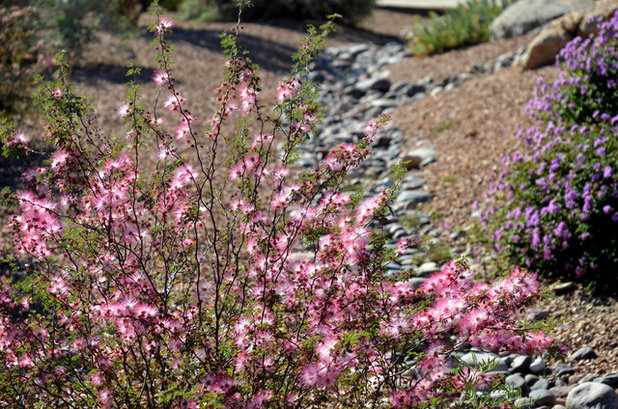
Noelle Johnson Landscape Consulting
1. Pink Fairy Duster(
Calliandra eriophylla)
Native to the desert Southwest and also grows in northern Mexico
This Southwestern native’s airy foliage is transformed in spring by the arrival of pink flowers that resemble feather dusters. Not only do people enjoy the beauty of these flowers, but hummingbirds can’t get enough of them.
While pink fairy duster is able to survive on natural rainfall, its appearance as well as the amount of flowers produced are improved when it is watered deeply once a month in spring and fall and twice a month in summer.
Where it will grow: Hardy to 10 degrees Fahrenheit, or minus 12 degrees Celsius (USDA Zone 8; find your zone)
Water requirement: Low
Light requirement: Full sun is best, but it can handle filtered shade for a few hours a day.
Mature size: 3 feet tall and 4 feet wide
See how to grow pink fairy duster
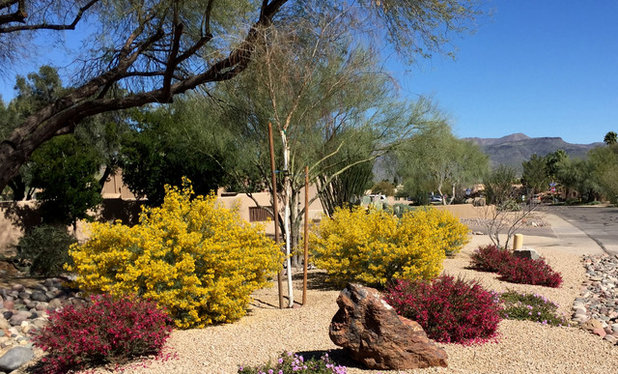
Noelle Johnson Landscape Consulting
2. Feathery Cassia(
Senna artemisioides,
formerly
Cassia artemisioides)
Native to the arid regions of Australia
Fragrant yellow flowers cover finely textured gray-green leaves from late winter into early spring, adding color to the cool-season landscape. Here we see it contrasted by red ‘Valentine’ bush (
Eremophila maculata ‘Valentine’)
When not in flower, the foliage of this Australian native adds a soft shade of green that contrasts darker green plants. As a bonus, the foliage appears to turn silvery gray when blown by the wind.
Where it will grow: Hardy to 15 degrees Fahrenheit, or minus 9.4 degrees Celsius (Zone 8)
Water requirement: Low
Light requirement: Full, reflected sun to light shade
Mature size: 6 feet tall and 8 feet wide
See how to grow feathery cassia
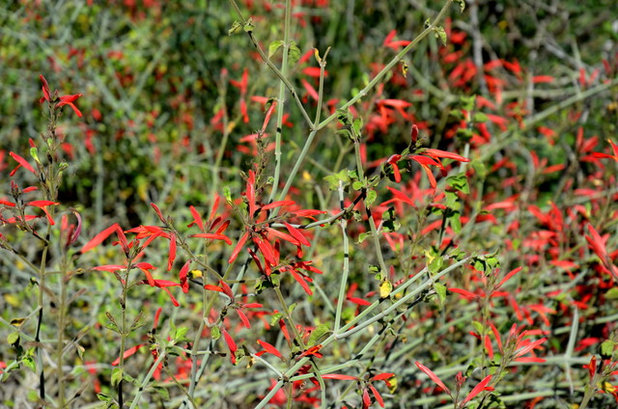
Noelle Johnson Landscape Consulting
3. Chuparosa(
Justicia californica)
Native to the Sonoran Desert
The landscape comes alive in winter when red trumpet-shaped flowers appear. Bright green heart-shaped foliage adds a visually cooling element to the landscape and may be absent during times of drought.
Hummingbirds flock to the flowers, which are perfectly shaped for their long beaks and are a vital source of nectar when not much else is in bloom.
Where it will grow: Hardy to 20 degrees Fahrenheit, or minus 6.7 degrees Celsius (Zone 9)
Water requirement: Low
Light requirement: Full sun to light shade
Mature size: 3 feet tall and 4 to 5 feet wide
See how to grow chuparosa
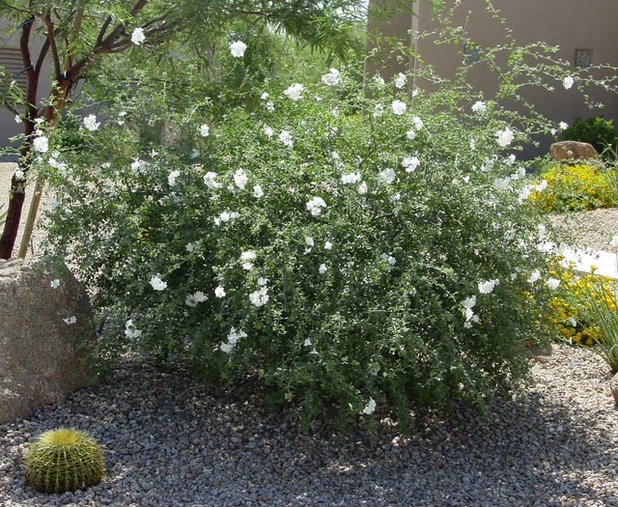
Noelle Johnson Landscape Consulting
4. Little-Leaf Cordia(
Cordia parvifolia)
Native to the desert regions of Mexico, including Baja, Chihuahua and Sonora
The papery white flowers of this Mexican native add a neutral color that enhances the impact of other colors in the landscape. Despite the delicate appearance of its flowers, this large shrub is anything but. Little-leaf cordia’s ability to handle the heat and sun, as well as periods of drought, makes it a popular choice for low-maintenance landscapes.
Where it will grow: Hardy to 15 degrees Fahrenheit, or minus 9.4 degrees Celsius (Zone 8)
Water requirement: Low
Light requirement: Full, reflected sun or light shade
Mature size: 4 to 8 feet tall and 4 to10 feet wide
See how to grow little-leaf cordia
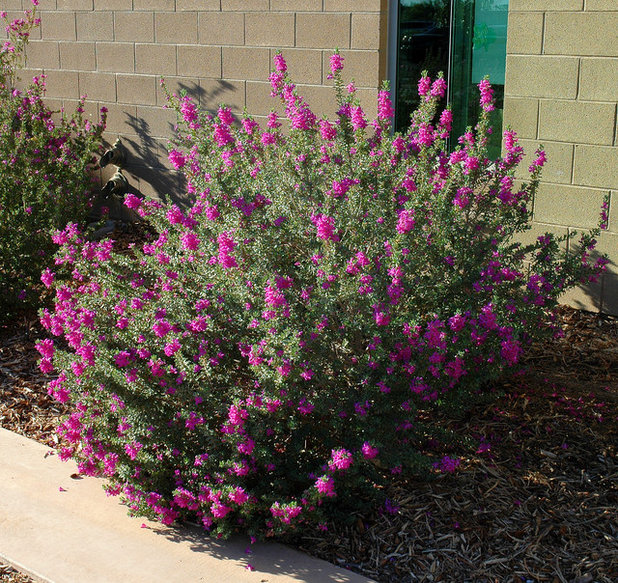
Noelle Johnson Landscape Consulting
5. Texas Ranger(
Leucophyllum frutescens)
Native to the Chihuahuan Desert
Commonly referred to as barometer bush, Texas ranger welcomes flushes of purple flowers at the onset of increased levels of humidity throughout the warm season, often occurring after periods of rain.
The gray foliage is covered with tiny hairs that help to reflect the sun’s rays while giving it a velvety texture. ‘Green Cloud’ is a popular variety of Texas ranger in a darker shade of green. The beauty of this shrub is best appreciated when it is allowed to grow into its natural shape, rather than being pruned into formal shapes.
Where it will grow: Hardy to 10 degrees Fahrenheit, or minus 12.2 degrees Celsius (Zone 8)
Water requirement: Low to moderate
Light requirement: Full sun to light shade
Mature size: 5 to 8 feet tall and wide
See how to grow Texas ranger
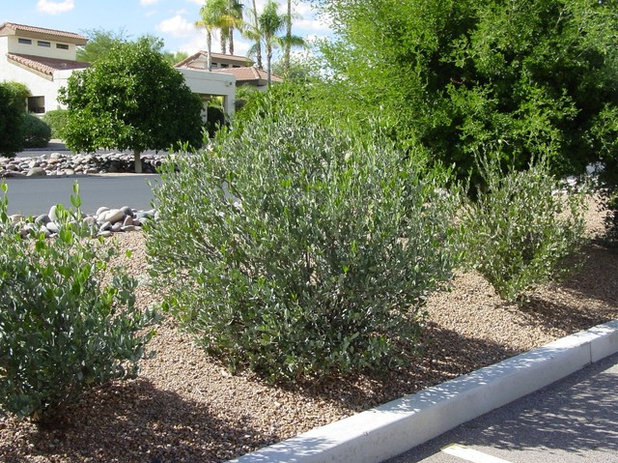
Noelle Johnson Landscape Consulting
6. Jojoba(
Simmondsia chinensis)
Native to the desert regions of Arizona and California as well as Baja and Sonora, Mexico
This evergreen shrub is prized for its attractive evergreen foliage, rather than its flowers. Each leaf is covered in a waxy coating that helps it withstand hot temperatures and reflected heat. In addition, its leaves are arranged vertically, which helps them to avoid direct sun.
Jojoba can be allowed to grow into its natural shape, but it can also handle being formally pruned. Extracts from the fruit of this shrub are used for a variety of cosmetics.
Where it will grow: Hardy to 15 degrees Fahrenheit, or minus 9.4 degrees Celsius (Zone 8)
Water requirement: Low
Light requirement: Full sun to light shade
Mature size: 6 feet tall and 10 feet wide
See how to grow jojoba
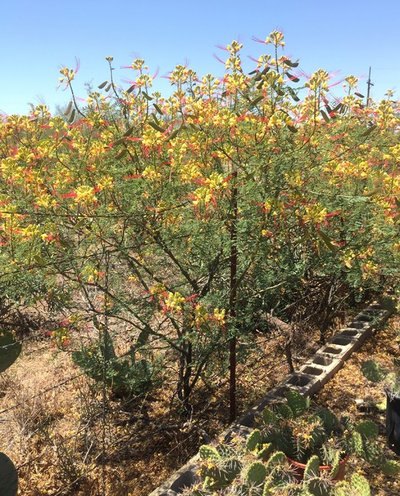
Noelle Johnson Landscape Consulting
7. Yellow Bird-of-Paradise(
Caesalpinia gilliesii)
Native to South America, primarily Argentina and Uruguay
The finely textured foliage of this South American native adds a lacy element to the garden. Large yellow flowers with long red stamens create colorful interest in hot, sunny areas of the garden throughout summer.
While several types of Caesalpinia are popular choices in warm regions, this particular species not only handles temperatures over 100 degrees Fahrenheit (37.8 degrees Celsius), but it can also survive areas that experience temperatures down to minus 10 degrees Fahrenheit (minus 23.3 degrees Celsius).
Caution: All parts of this shrub are toxic; it has naturalized in moist, humid climates in Central America.
Where it will grow: Hardy to minus 10 degrees Fahrenheit, or minus 23.3 degrees Celsius (Zone 6)
Water requirement: Low to moderate
Light requirement: Full sun
Mature size: 8 feet tall and 6 feet wide
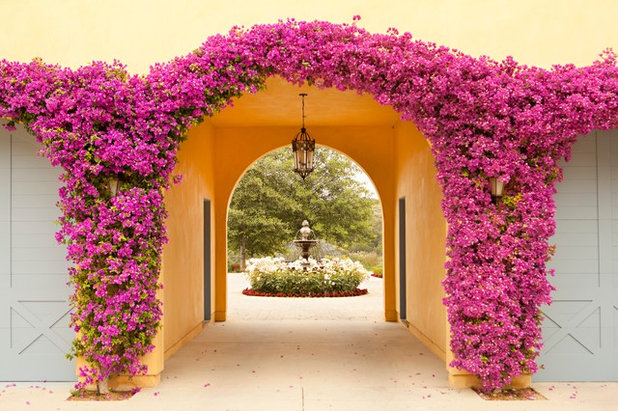
Biglin Architectural Group
8. Bougainvillea(
Bougainvillea spp.)
Native to South America
Bougainvillea’s vibrant colors herald the arrival of spring, adding a dramatic statement to the landscape. Interestingly, the color comes from bracts that surround tiny cream flowers.
Lush green foliage adds beauty wherever bougainvillea is planted and also hides thorns beneath. Bougainvillea relishes areas with full sun and reflected heat, and does best when irrigated deeply and allowed to dry out before being watered again.
Where it will grow: Hardy to 20 degrees Fahrenheit, or minus 6.7 degrees Celsius (Zone 9)
Water requirement: Low to moderate
Light requirement: Full sun to light shade
Mature size: 15 to 30 feet tall and 10 to 20 feet wide
See how to grow bougainvillea
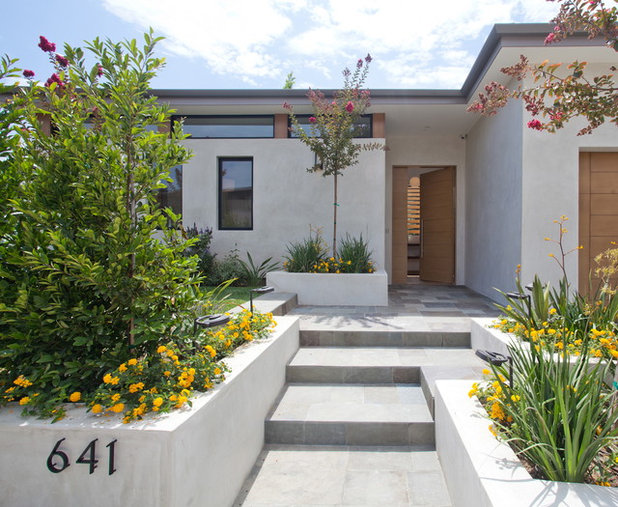
Building Solutions and Design, Inc
9. ‘New Gold’ Lantana(
Lantana ‘New Gold’)
Native to South America
Butterflies are attracted to this lantana species’ golden yellow flowers, which cover bright green foliage spring through fall. The low growth habit makes this shrub a great choice for adding color at lower heights in garden hot spots.
Lantana’s leaves are aromatic and roughly textured. While this South American native is commonly grown in zones 9 to 11, its roots will survive winters down to Zone 8. Gardeners in more temperate zones can grow lantana as an annual in summer.
Where it will grow: Hardy to 10 degrees Fahrenheit, or minus 12 degrees Celsius (Zone 8)
Water requirement: Moderate
Light requirement: Full sun to light shade
Mature size: 18 inches tall and 3 feet wide
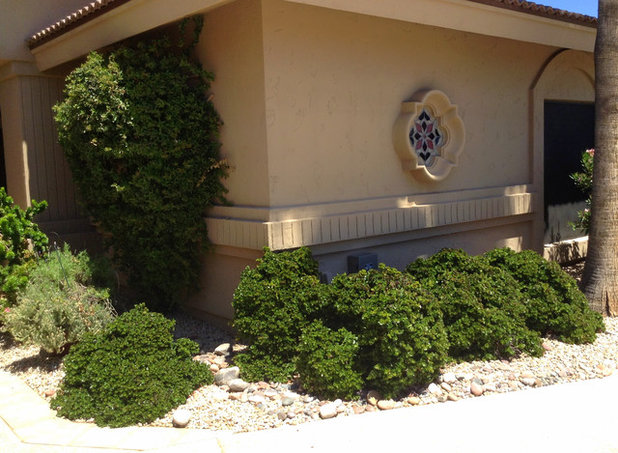
Noelle Johnson Landscape Consulting
10. Natal Plum(
Carissa macrocarpa)
Native to South Africa
Attractive dark green leaves make natal plum, a small to medium shrub, a popular alternative to boxwood (
Buxus spp.), which can struggle in intensely sunny exposures. White star-shaped flowers appear in spring, which are often described as having a fragrance similar to that of jasmine and orange blossoms. This shrub produces small dark red fruits, which are edible.
Varieties of this South African native range in size from 1 foot tall all the way to 8 feet, making it easy to find one that is just right for a sunny area of any size. Frost damage does occur when temperatures dip below freezing.
Caution: The sap of natal plum can irritate the skin, and it has thorns.
Where it will grow: Hardy to 20 degrees Fahrenheit, or minus 6.7 degrees Celsius (Zone 9)
Water requirement: Moderate
Light requirement: Full sun to light shade
Mature size: 1 foot to 6 feet tall and 2 to 3 feet wide, depending on the variety





